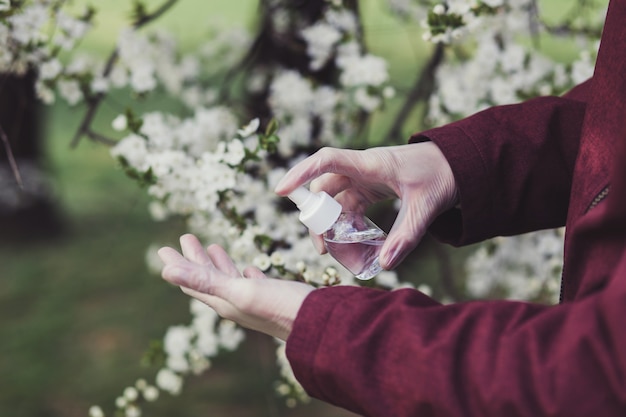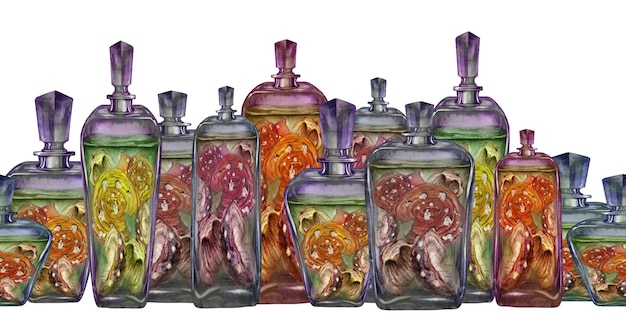The Power of Scent: Choosing a Perfume That Reflects You

The Power of Scent: Choosing a Perfume That Reflects Your Personality involves understanding how different fragrance notes and accords can align with your individual characteristics, preferences, and desired self-image, creating a harmonious olfactory signature.
Ever wondered if your perfume could be more than just a pleasant smell? The Power of Scent: Choosing a Perfume That Reflects Your Personality is about finding that perfect fragrance that truly represents who you are. Let’s delve into the aromatic world and find your olfactory match!
Unlocking the Olfactory Code: The Psychology of Perfume
Perfume is more than just a fragrance; it’s a powerful form of non-verbal communication. Our sense of smell is directly linked to the limbic system, the part of the brain responsible for emotions and memories. This connection explains why certain scents can evoke strong feelings and associations.
The Scent-Emotion Connection
The link between scent and emotion is profound. Think about the smell of freshly baked bread, often associated with comfort and home, or the scent of pine trees, which might remind you of a winter holiday. These associations are highly personal and greatly influence our perfume preferences.
Perfume as a Reflection of Self
Choosing a perfume that reflects your personality involves understanding what emotional responses different scents elicit in you. A bold, spicy fragrance might appeal to someone confident and outgoing, while a light, floral scent may resonate with a more delicate and introverted nature.
- Understand Your Preferences: Identify the scents you naturally gravitate towards. Do you prefer floral, woody, citrus, or spicy notes?
- Consider Your Lifestyle: Think about your daily activities and the image you want to project. A subtle scent might be better for the office, while a bolder fragrance could be perfect for evening events.
- Experiment and Explore: Visit perfume counters and sample different fragrances. Don’t be afraid to try new things and step outside your comfort zone.
Ultimately, the psychology of perfume is about understanding how scents can influence our emotions and how we can use them to express ourselves authentically. By choosing a fragrance that aligns with your personality, you can create a positive and memorable impression.

Deciphering Fragrance Families: Finding Your Olfactory Tribe
The world of perfume can seem overwhelming at first, but understanding fragrance families can simplify the selection process. Perfumes are typically categorized into families based on their dominant scent characteristics. Knowing these families and their associated traits can help you narrow down your options.
The Main Fragrance Families
There are four primary fragrance families: floral, oriental, woody, and fresh. Each family encompasses a variety of sub-categories and scent combinations, offering a wide range of options to suit different preferences.
Floral: The Essence of Bloom
Floral fragrances are among the most popular, characterized by sweet and powdery notes. These perfumes often evoke feelings of femininity and romance. Common floral notes include rose, jasmine, lily, and tuberose. Floral fragrances can range from light and airy to rich and intoxicating, making them versatile for various occasions.
Oriental: Exotic and Sensual
Oriental fragrances are known for their warm, spicy, and exotic notes. These perfumes often contain ingredients like vanilla, cinnamon, cloves, and amber. Oriental scents are typically rich and long-lasting, making them ideal for evening wear and special occasions. They project an aura of mystery and sensuality.
Woody: Earthy and Grounded
Woody fragrances are characterized by earthy and grounding notes, often featuring ingredients like sandalwood, cedarwood, vetiver, and patchouli. These scents evoke feelings of warmth, comfort, and sophistication. Woody perfumes are versatile and can be worn by both men and women, making them a popular choice for everyday wear.
Fresh: Clean and Invigorating
Fresh fragrances are known for their clean, crisp, and invigorating notes. These perfumes often contain ingredients like citrus fruits, aquatic accords, and green herbs. Fresh scents are light and refreshing, making them perfect for daytime wear and warmer मौसम. They project an image of cleanliness and vitality.
- Floral: Best for those who are romantic, feminine, and love classic scents.
- Oriental: Ideal for individuals who are bold, sensual, and enjoy making a statement.
- Woody: Suited for people who are grounded, sophisticated, and appreciate natural scents.
- Fresh: Perfect for those who are energetic, active, and prefer clean, refreshing fragrances.
Understanding fragrance families is essential for choosing a perfume that aligns with your personality and preferences. By exploring different families and experimenting with various scents, you can discover your olfactory tribe and find the perfect fragrance to express your unique self.
Decoding Scent Notes: The Building Blocks of Perfume
Every perfume is composed of different scent notes, which are the individual components that create the overall fragrance. These notes are typically categorized into top, middle, and base notes, each of which plays a unique role in the perfume’s evolution on your skin.
The Three Layers of Scent
The interplay of top, middle, and base notes determines the complexity and longevity of a perfume. Understanding these layers can help you appreciate the artistry and craftsmanship that goes into creating a fragrance.
Top Notes: The First Impression
Top notes are the initial scents you perceive when you spray a perfume. These notes are typically light and volatile, designed to create an immediate impression. Common top notes include citrus fruits (like lemon, grapefruit, and orange), green herbs (like mint and basil), and light fruits (like berries and apple). Top notes are often refreshing and invigorating, but they tend to fade quickly, lasting only about 15-30 minutes.
Middle Notes: The Heart of the Fragrance
Middle notes, also known as heart notes, emerge as the top notes fade. These notes form the core of the fragrance and provide its dominant character. Common middle notes include floral scents (like rose, jasmine, and lavender), spicy notes (like cinnamon and nutmeg), and fruity notes (like peach and apricot). Middle notes are typically well-rounded and balanced, lasting for several hours.
Base Notes: The Lasting Impression
Base notes are the foundation of the fragrance, providing depth and longevity. These notes emerge as the middle notes fade and linger on the skin for several hours or even days. Common base notes include woody scents (like sandalwood, cedarwood, and patchouli), musky notes, and sweet notes (like vanilla and amber). Base notes are often rich and grounding, creating a lasting impression.
Decoding scent notes is crucial for choosing a perfume that evolves beautifully on your skin and reflects your personal preferences. By understanding the three layers of scent, you can appreciate the complexity and artistry of perfume creation and find a fragrance that truly resonates with you.
Perfume Personalities: Matching Scents to Temperaments
Just as people have different personalities, so do perfumes. Matching scents to temperaments involves understanding how certain fragrance profiles resonate with different personality traits. This can help you choose a perfume that enhances your natural qualities and expresses your unique self.
The Confident Extrovert
Confident extroverts often gravitate towards bold and attention-grabbing fragrances. These individuals are not afraid to make a statement and enjoy wearing perfumes that reflect their outgoing nature. Ideal scent profiles include oriental, spicy, and woody notes, which project an aura of confidence and sensuality.
The Creative Introvert
Creative introverts typically prefer subtle and unique fragrances that reflect their introspective nature. These individuals appreciate perfumes that are complex and intriguing, but not overpowering. Ideal scent profiles include floral, green, and aquatic notes, which evoke feelings of tranquility and inspiration.
The Romantic Idealist
Romantic idealists often gravitate towards classic and feminine fragrances that evoke feelings of love and romance. These individuals appreciate perfumes that are delicate and timeless. Ideal scent profiles include floral, fruity, and powdery notes, which project an aura of sweetness and grace.
The Practical Realist
Practical realists typically prefer clean and versatile fragrances that are suitable for everyday wear. These individuals appreciate perfumes that are understated and reliable. Ideal scent profiles include citrus, herbal, and woody notes, which evoke feelings of freshness and practicality.
- Confident Extrovert: Bold oriental or spicy scents.
- Creative Introvert: Subtle green or aquatic scents.
- Romantic Idealist: Classic floral or fruity scents.
- Practical Realist: Clean citrus or herbal scents.
By understanding these perfume personalities, you can choose a fragrance that aligns with your temperament and enhances your natural qualities. This can help you project an authentic image and feel more confident in your own skin.

Navigating the Perfume Aisle: Tips for Testing and Buying
The perfume aisle can be a daunting place, with countless bottles and fragrances vying for your attention. Navigating this space effectively involves knowing how to test perfumes properly and make informed buying decisions.
Testing Perfumes the Right Way
Testing perfumes properly is essential for understanding how they will smell on your skin and whether they are a good fit for your preferences. This involves more than just spraying a scent strip and making a snap judgment.
Spraying on Blotter Strips
Start by spraying perfumes on blotter strips. This allows you to evaluate the initial scent without the influence of your skin chemistry. Make notes on the strips to remember which perfumes you like.
Testing on Your Skin
Next, test your favorite perfumes on your skin. Spray a small amount on your wrist or inner elbow. Avoid rubbing the perfume, as this can alter the scent. Allow the perfume to develop on your skin for several hours, noting how the top, middle, and base notes evolve.
Considering the Environment
Consider the environment in which you are testing perfumes. Perfume counters can be overwhelming, with many competing scents. Try to test only a few perfumes at a time to avoid olfactory fatigue. Take breaks and step outside for fresh air to reset your sense of smell.
Making Informed Buying Decisions
Making informed buying decisions involves considering your personal preferences, lifestyle, and budget. Don’t be swayed by marketing hype or designer labels. Choose a perfume that you genuinely love and that makes you feel confident and happy.
- Test on blotter strips first.
- Test on your skin and allow the scent to develop.
- Consider the environment when testing.
- Choose a perfume that you genuinely love.
By following these tips for testing and buying, you can navigate the perfume aisle with confidence and find the perfect fragrance to express your unique personality.
Creating Your Olfactory Signature: Layering and Personalization
Creating your olfactory signature involves layering and personalizing your fragrances to create a scent that is uniquely yours. This can be a fun and creative process, allowing you to express your individuality and create a memorable impression.
The Art of Layering
Layering involves combining multiple fragrances to create a custom scent. This technique allows you to tailor your perfume to your mood, the season, or the occasion. Start with a base fragrance and then add complementary scents to create depth and complexity.
Choosing Complementary Scents
When layering fragrances, choose scents that complement each other. For example, you might layer a floral perfume with a woody or citrus scent to create a balanced and interesting aroma. Experiment with different combinations to find what works best for you.
Personalization Through Application
You can also personalize your fragrance through the way you apply it. Applying perfume to different pulse points, such as your wrists, neck, and behind your ears, can create a more nuanced and long-lasting scent. You can also try spraying perfume on your hair or clothing for a subtle and lingering aroma.
Creating your olfactory signature is a journey of self-discovery, allowing you to express your unique personality through scent. By experimenting with layering and personalization, you can create a fragrance that is truly your own and leaves a lasting impression.
| Key Point | Brief Description |
|---|---|
| 🧠 Psychology of Scent | Scent linked to emotions; perfume reflects self. |
| 🌸 Fragrance Families | Floral, oriental, woody, and fresh. Find your tribe. |
| 👃 Scent Notes | Top, middle, and base notes create perfume’s character. |
| 🧪 Layering Scents | Combine scents for a unique, personalized fragrance. |
Frequently Asked Questions
▼
Consider your emotional responses to different scents. Choose a fragrance that aligns with your traits, such as floral for romantics or bold oriental scents for confident extroverts.
▼
The main fragrance families include floral, oriental, woody, and fresh. Each family has unique characteristics that cater to different olfactory preferences and personality types.
▼
Top notes are the initial, fleeting scents; middle notes form the fragrance’s core; and base notes provide depth and longevity, creating a lasting impression.
▼
Start by spraying on blotter strips, then test on your skin to see how the scent evolves. Consider the environment and avoid testing too many perfumes at once to prevent olfactory fatigue.
▼
Yes, layering perfumes allows you to blend different fragrances to create a personalized scent. Experiment with complementary scents to achieve depth and complexity that reflects your style.
Conclusion
Choosing a perfume that reflects your personality is a journey of self-discovery. By understanding fragrance families, scent notes, and how scents align with your temperament, you can create an olfactory signature that is uniquely yours. So, explore the aromatic world, experiment with different fragrances, and find the perfect scent to express your true self.
